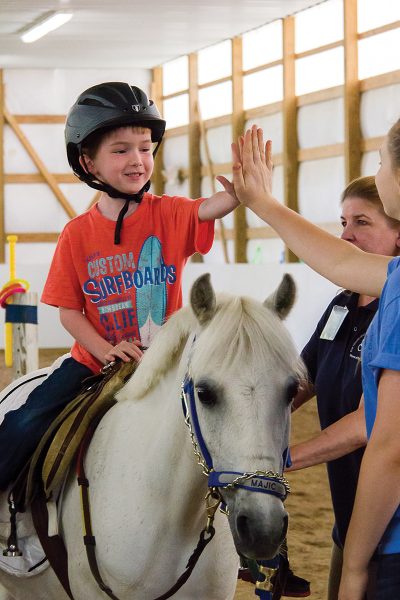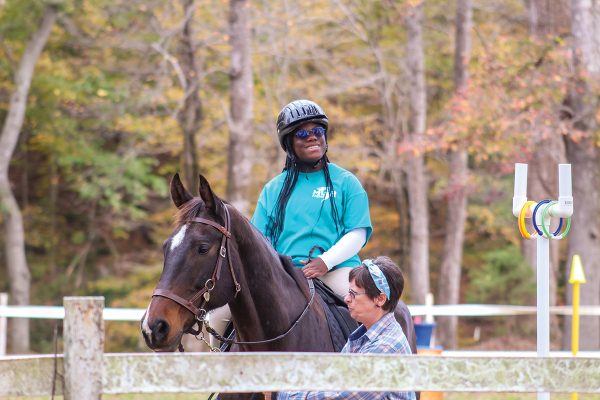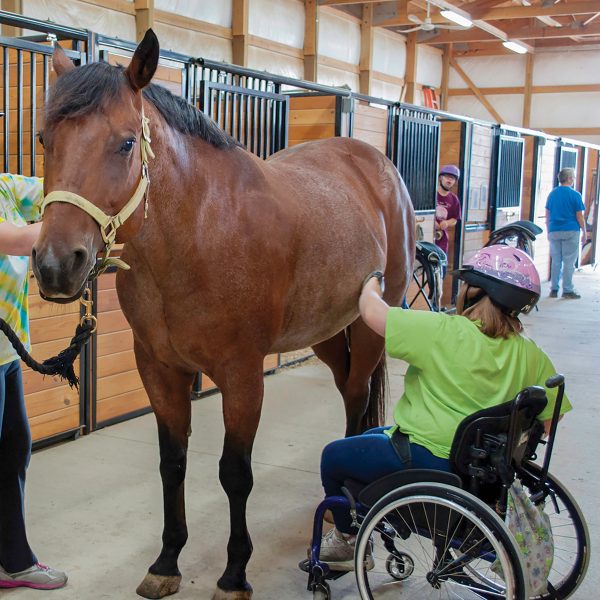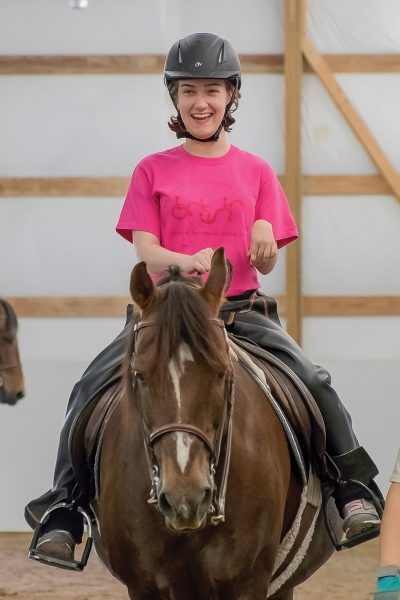A hero is an individual admired for their courage, outstanding achievements, or noble qualities. Therapeutic riding horses earn that “hero” title every time they are led out of their stalls to do their very important jobs.

Horses used for therapeutic riding and adaptive horsemanship change the lives of the people they work with in many ways: They help children and adults with physical and mental disabilities, emotional trauma, and learning difficulties. They give mobility to those who can’t walk on their own and so much more. These horses are partners, teachers and friends.
Working with these special equines can help people improve sensory and motor skills for better coordination, balance and posture. They may also gain increased body strength, confidence and independence, and learn teamwork.
Real Stories
Here are two stories of heroic therapeutic riding horses in action, both from Professional Association of Therapeutic Horsemanship International (PATH Intl.) Premier Accredited Centers.
Kate Storjohann is lead instructor at the Marianna Greene Henry Special Equestrian Program (MGHSE) in Talladega, Ala., where she works with deaf, blind and multi-disabled students. She has witnessed many examples of the healing power of horses, but one story stands out.

Kate was teaching a blind, autistic student who had not spoken to anyone in the three years she had been going to MGHSE.
“I was working with her one-on-one, grooming horses, when something wonderful happened,” she shares. “As we brushed, I started to guide her hand over different parts of the horse and tell her what she was feeling. After a few minutes, she started reaching out on her own. I could tell she was beginning to take an interest, so I repeated the parts of the horse. Then she said, ‘Mane?’ I had never heard her speak before! Since that day, I can ask her to find the ear, eye, nose, mane, tail, and many other parts, and she can show me where they are.”
At Therapeutic Riding Incorporated (TRI) in Ann Arbor, Mich., Program Director Jennifer Beyer has also seen her share of miracles worked by the horses in their adaptive horsemanship program. Jennifer recalls many examples, but the story of one young man and his bond with TRI’s Quarter Horse gelding, B Smiley, illustrates the restorative abilities of a horse.
Liam had been a student at TRI for several years when ongoing neurological issues caused him to be hospitalized for weeks at a time.
“With every hospital stay, Liam looked forward to time at TRI,” Jennifer says. “Coming to the barn to see ‘his’ horse, B Smiley, became his motivation to get better. B Smiley has impeccable ground manners. When the doctors gave him the ‘all clear,’ Liam wasn’t strong enough to ride, but he came to every lesson to groom and walk B Smiley. Fast forward a year, Liam is now strong enough to ride and has made great strides with improved balance. He and B Smiley are still a team both in and out of the saddle.”

What it Takes to be a Therapeutic Riding Horse
Horses, ponies, donkeys and mules used in work to help humans with various disabilities are considered therapeutic riding animals. The work consists of both mounted exercises and working with these equines from the ground.
If horses are used in programs where a licensed medical professional is present, it is called “therapy.” If the equestrian program is instead directed by a riding instructor certified by PATH Intl., then the work is called “therapeutic” or “adaptive horsemanship.” But in either case, the horses are doing meaningful work under watchful supervision.
Qualities needed for an equine to be good for therapeutic riding or adaptive horsemanship are:
◆ Trained adult animal in current work.
◆ Height range between 14-16 hands, with some exceptions.
◆ Healthy, with negative Coggins test and up to date on veterinary and farrier care.
◆ Sound in all gaits; can smoothly transition from one gait to another.
◆ Comfortable being handled and ridden by a wide variety of people.
◆ Good ground manners; leads, ties and stands well.
◆ Stands quietly for mounting and dismounting.
◆ Respects a human leader’s personal space and is tolerant of multiple sidewalkers (humans who walk on both sides of the horse while a student is riding).
◆ Accepting of beginner riders; tolerant and even-tempered so a student riding may be safely led.
◆ Obedient to voice and leg aids.
◆ Accepting of assistive devices (wheelchairs, walkers, et cetera).
◆ Able to calmly deal with new sights, sudden sounds, and unexpected/uneven movement by the rider.
◆ Shows enjoyment in their work.

Therapeutic riding/adaptive horsemanship equines come from various walks of life, but most often are from show, lesson and trail backgrounds. Many programs accept donated horses and also purchase some.
The horses go through training and desensitization once they arrive, as well as refresher courses as needed. They are well cared for and loved by many!
For more information, visit the Professional Association of Therapeutic Horsemanship International (PATH Intl.) at pathintl.org, the Marianna Greene Henry Special Equestrian Program (MGHSE) at aidb.org/mgh, and Therapeutic Riding Incorporated (TRI) at therapeuticridinginc.org.
This article about therapeutic riding horses appeared in the May/June 2023 issue of Young Rider magazine. Click here to subscribe!


